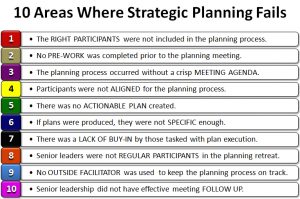
This is a process that enables everyone to be aligned with the direction. It creates a road map, blueprint or whatever analogy you want to use. It can be done for a whole organization or a long term project. It enables you and your staff or just you to ask where you are going, does it make sense, how will we get there, what do we need, and do we have the resources?
Remember If you fail to plan you plan to fail!
Increased Organizational Alignment
You have a wealth of information from your past and the experience of others. Use this to create an alignment so everyone can be on the same page. They understand the direction of the business and what the goals and objectives are. They also get to know the strengths and weaknesses of your small business, as well as the opportunities and threats posed in your specific industry. You can create an exchange of ideas and opinions. Because everyone is involved in the strategic planning process, it creates a sense of accountability for your employees. They will know what you want to accomplish with the business and they’ll focus and work toward achieving the identified goals.
When the direction of the company is spelled out in your strategic plan, everyone knows where you’re going; not just your employees, but also people outside of your company. The public, customers, clients, vendors, and investors will know how you want your business to move forward.
In your strategic planning meetings with your team, ask them questions about the business. Use Appreciative Inquiry for the discussion (note: if you want help using this method which is great for focus groups, stay interviews, exit interviews and planning sessions, just ask me) Ask what are you most proud of working here? What would like to see more of? If you could create something to make your job, the company, the product or whatever better what would it be?
Don’t forget customers, vendors and investors and others to learn about trends and competition. Important caveat, you want to know what your competition is doing to differentiate not emulate.
When you have gathered enough information, you can determine the best path to follow to help your business grow and succeed. The first step is to do a SWOT analysis to help you see opportunities
If you need help contact me or go to the website and there is an e-book for only $5.99 that will help you with the process.
A SWOT helps build competitive advantage by enabling you to identify opportunities and threats. It helps you understand how you differentiate yourself from the competition and what you need to do to fix weaknesses.
The next step is review the mission and values making sure there is agreement. The mission may need to change. It should focus on why you and the others do what you do.
Now you create the vision for the next 3 to 5 years. This not written in stone and could change. let’s face it many visions changed this year; who knew we would have a pandemic?
Set Business Goals
Strategic planning also gives you the opportunity to set meaningful, realistic, and measurable goals and objectives.
A measurable goal includes a timeline and specific quantity. For example, one of your goals for your business may be to have retained 60% of your customers at year-end.
Don’t be afraid to have a mix of short-term and long-term goals and objectives. This allows people to see what you want the business to accomplish within a year, while also knowing what to work toward for the next two or three years.
Here are some examples of short- and long-term goals and objectives:
- Increase this year’s revenue by 10%
Increase customer satisfaction by 25% over the next two years - Develop one new product to meet customer demand
- Increase brand awareness by 10%
When it comes to setting goals and objectives for your small business, it’s important to be realistic. While everyone wants to see their business grow in the future, it may be unattainable to triple the size of your customer base within a year.
Evaluating Progress
This is an ongoing process. DO NOT put the plan on the shelf and say we did it. The strategic plan is a living breathing document. OK, maybe not living, breathing but it is a guide that must be reviewed and modified as needed. Accountability and milestones are key along with celebrations.
Part of the plan is an implementation plan. Think about going on a trip; you have your map now you need to identify who is responsible for reservations, packing, checking the car, or whatever else needs to be done. You will have a list of milestones to identify what has been achieved to make the plan work. There is also monitoring to assure things do not get ignored. A bonus is your staff will have assignments and be accountable as well as you. Set scheduled meetings to review and change things if needed.
What’s important is that strategic planning puts your business in a proactive position. You won’t be making decisions with a reactive mentality, but rather you’ll be in an anticipatory mindset. This gives you a competitive advantage and a better opportunity to grow and succeed.For a small business owner, strategic planning helps you create a document that details the current status of the company and the direction you want to take it in. It’s a process that helps your employees understand what the goals and objectives are and that contributes to the growth and success of your small business.
The strategic planning process takes time, but both the process and the outcomes are valuable. It should be used at every stage of your business from start-up to mature. Below are some pitfalls to avoid.

Have you created a strategic plan for your small business? Has it helped you stay on track?Let us know in the comments.
Recent Comments